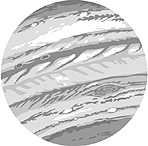 Not Just for Kids
Not Just for Kids Not Just for Kids
Not Just for Kids
Summer Star Gazing
by Guest Editor Saul D. Cohen
Look at the sky tonight. What's the brightest thing you'll see? (Other than the moon, of course.) It's not a star. It's a planet, in this case, Jupiter, which is currently about 10 times brighter than the brightest star in the sky. If you have binoculars, now is a great time to look for the Galilean Satellites. These four large moons of Jupiter are very important in astronomy history. They are the very first things discovered with atelescope, by Galileo in the 1600s. Today anyone with binoculars can discover these moons for themselves, and there are many more.
Discover the Moons
First, locate Jupiter. It is a very bright star-like object in the Eastern sky. (East is where the Sun rises; if you can't remember that, use a compass). Jupiter rises this week around 9:15 pm so it should be high in the sky before 11. Just aim your binoculars at Jupiter. The planet will still look small like a star, but if you look nearby you should be able to see one or more dim specks.
Congratulations! You've discovered the Galilean moons of Jupiter. Astronomers
have since found as many as 13 additional moons of Jupiter.
The Galilean moons are named
If you can't see the moons of Jupiter, it may be cloudy and a bad night for star gazing. Or you may be a victim of light pollution.
Light Pollution
Normally, you can't see most of the wonders of the sky, due to something called light pollution. Just like regular pollution, light pollution is light that gets away into the environment.
Light pollution is the worst in cities and near strong lights (like stadium lights). Even though the sky looks dark, it's filled with light pollution, blotting out most of the stars in city areas.
If you ever escape from light pollution during the summer, you'll probably be able to see a faint stream of light arching across the sky. It's not a cloud; it's actually our galaxy, the Milky Way. The Milky Way is made up of billions of stars so faint that they all blur together.
More Summer Sights
The Summer Triangle is an asterism that is high in the sky during the summer. It is made up of three large bright stars. The stars are named Vega, Altair and Deneb. It's easy to find the Summer Triangle. Just look overhead for three bright stars.
-Saul D. Cohen is an astronomy major at the University of Maryland, College Park, where he is also majoring in math, computer science and physics. He lives in Anne Arundel County and loves astronomy "because the universe is so huge and weird."
Visit the sky on the Web
Each day a new astronomy picture appears, thanks to the Laboratory for High Energy Astrophysics at Goddard Space Flight Center, nearby in Greenbelt, Maryland.
Check it out at:http://anytwrp.gsfc.nasa.gov/apod/astropix.html
Sound like a real astronomer
Zenith - the spot in the sky directly overhead
Nadir - the spot directly beneath your feet, opposite Zenith
Transit - the highest point reached by an object in the sky. Example: the Sun transits at noon
Constellation - one of 88 shapes in the sky
Asterism - any group of stars that isn't a constellation. Example: the Summer Triangle
Circumpolar - anything which is always in the sky, regardless of season. Circumpolar means around the pole. Example: the Big Dipper is circumpolar to the North Pole. Since we live in the Northern Hemisphere, this constellation is in our sky all the time.
| Back to Archives |
VolumeVI Number 31
August 6-12, 1998
New Bay Times
| Homepage |